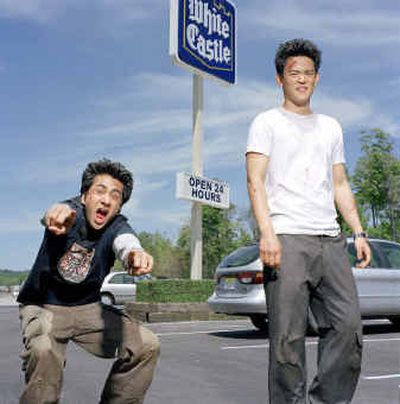Pioneering pair

Cinematic history will be made this month through the unlikeliest of heroes: Harold and Kumar, two stoners from New Jersey on a quest to satisfy a case of the munchies.
On the surface, “Harold and Kumar go to White Castle,” which hits theaters Friday, is your average summer teen gross-out flick.
But behind the burps and potty humor is something remarkable: the first mainstream Hollywood comedy to star two Asian-American actors.
The buddy comedy genre is nothing new. What’s novel is casting Asian or Asian-American men in starring roles other than martial arts masters.
The nerd, foreign exchange student, delivery boy, liquor store clerk or villain — usually bit parts with laughable accents — are other typecasts endured by Asian-American actors.
But Harold, played by John Cho, and Kumar, played by Kal Penn, are just two regular dudes who happen to be Asian-American.
“We’re hitting the Hollywood pinata, making some dents on several levels here,” says Cho, a Korean-American who gained a teen following as the “Asian guy” from the “American Pie” trilogy.
“You don’t see Asians headlining movies without an accent, and you don’t see Asians headlining comedies, because we’re stereotyped as not being funny enough.”
Historically, Hollywood’s famous Asian faces have been actors from Asia, including Hong Kong martial arts experts Jackie Chan and Chow Yun-Fat and Beijing-born Jet Li.
Hollywood movies that have cast Asian-Americans as leads are few and far between, with the roles being ethnic-specific.
“Better Luck Tomorrow” (2003), a crime drama, focused on a group of Asian-American teens but did not make “being Asian” part of the plot. But that movie, which had a budget of $250,000, had to earn its way to the big screen.
It was picked up by MTV Films only after generating buzz at film festivals.
On the other hand, “Harold and Kumar” had a $9 million budget funded by Hollywood powerhouse New Line Cinema.
The story follows post-college pals Harold and Kumar on a farcical 24-hour journey across the Garden State. The script, written by Jon Hurwitz and Hayden Schlossberg, two white Jewish 26-year-olds from New Jersey, doesn’t use ethnicity as the driving focus of the film. But the writers didn’t ignore the characters’ Asian-American backgrounds either.
For instance, Kumar Patel, the persistent partier, makes half-hearted attempts to gain entrance into medical school to appease his demanding physician father and older brother, a familiar story some real-life Asian-Americans can relate to. And both Harold and Kumar are subject to racist insults by various characters in the film.
While they were in college, Hurwitz and Schlossberg wrote the script specifically for two Asian-American leads, basing the characters on their Korean-American and Indian-American friends.
“Our friends had no accent, they liked to party and have fun, and they were no different than Hayden and I,” Hurwitz says, “But they were never portrayed accurately on the big screen.”
Director Danny Leiner says several studios were interested in the film but only if they changed the casting to either an African-American and a white guy pairing, or an Asian-American and an African-American pair — casting that has proved successful in action movies like “Lethal Weapon” and “Rush Hour.”
New Line not only bought the script in its original form, but has since poured millions of dollars into advertising the movie nationwide targeting the 17- to 25-year-old set.
“Studios are finally getting hip to the fact that people are excited about seeing portrayals of nonwhite characters in movies — especially kids, who are usually ahead of the curve and less fazed by race,” Leiner says.
According to a 2002 Screen Actors Guild casting report, only 2.5 percent of all theatrical film and television roles were cast to Asian-Americans, compared with 6 percent for Latinos and 15.5 percent for African-Americans.
Despite the numbers, Leiner says hundreds of would-be Harolds and Kumars came out for the movie’s casting calls.
“It’s obvious there’s no shortage of Asian-American actors out there,” he says.
What remains to be seen is whether “Harold and Kumar” will actually be the groundbreaking film that opens doors for Asian-Americans in mainstream films and whether it will launch Cho and Penn to larger stardom.
“The Joy Luck Club,” the 1993 film based on the Amy Tan novel, received critical acclaim but remains a relative blip in Asian-American film history. Greg Pak, editor in chief of asianamericanfilm.com, notes that “most of the actors in that movie are still working and have careers, but it didn’t make enormous stars out of any of them — to make the Asian-American Julia Roberts.”
Media experts say “Harold and Kumar” has the biggest potential so far to provide the break-out stars needed to keep a cycle going.
“The stars are young, wild and cool individuals who are also Asian-American,” says Jeff Yang, editorial director of “Stir,” a national television show about Asian-American pop culture.
“We’ve been inserted into the background in so many films serving as wallpaper for so long,” Yang says. “It’s so funny that this is revolutionary.
“It may turn out to be a baby revolution, but it’s a revolution.”